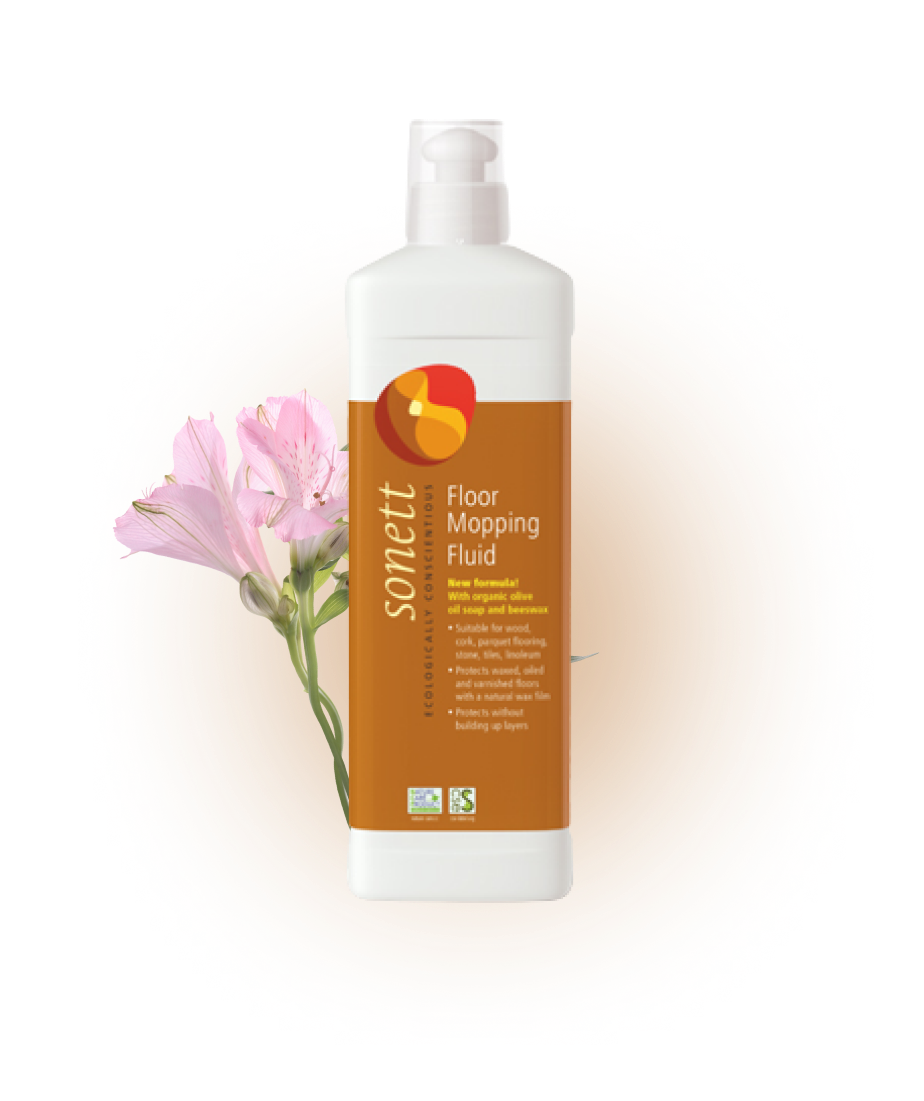Floor Mopping Fluid
Ingredients
Product declaration
Soap from olive oil, certified organically grown >30%
Beeswax 5–15%
Vegetable alcohol (ethanol) 5–15%
Sugar surfactants 5–15%
Carnauba wax, certified organically grown 1–5%
Essential cajuput oil, certified organically grown <1%
Balsamic additives, certified organically grown /
collection from wild-growing plants <1%
Water up to 100%
List of ingredients as per EC 648/2004
Aqua, potassium soap*, cera alba, alcohol denat., alkylpolyglucoside C8-C16 (coco glucoside), copernicia cerifera*,parfum*, linalool*, limonene*
*certified organically grown
Further information on INCI names ▶
Danger symbol
Warning
Contains essential cajuput oil, extract. May produce an allergic reaction. Causes skin irritation. Causes serious eye irritation. If medical advice is needed, have product container or label at hand. Keep out of reach of children. If in eyes: Rinse cautiously with water for several minutes. Remove contact lenses, if present and easy to do. Continue rinsing. If eye irritation persists: Get medical advice/attention.
Origin and properties of the ingredients
Beeswax and carnauba wax are used for, with a thin wax layer, gently protecting all surfaces made from wood, cork, linoleum, stone, etc. The organic carnauba wax is obtained from the leaves of the South American carnauba palm. Beeswax is a side product of apiculture whilst honey is being extracted from honeycombs by centrifuging.
The basis of this floor mopping fluid is organic olive-oil soap. Pure certified organically grown olive oil, by means of potassium hydroxide solution, is made into soap using a simple process without being exposed to external energy supply. Thanks to its slightly lipid-replenishing characteristics, the olive oil supports both wax components in their nourishing properties, furthermore having outstanding cleansing properties.
Ethanol, obtained by fermenting farinaceous plants or sugar-containing by-products such as molasses, helps maintaining the soap fluid, thus enabling a highly concentrated liquid product. Apart from its pleasantly refreshing fragrance, essential cajuput oil has a germ-inhibiting effect.
Technical data
Density: 20 °C approx.0.99 g / cm³
68 °F approx. 0.035 oz/ in³
pH value: 20 °C, 20 ml / 10 l H₂O
68 °F, 0.68 fl oz / 2.6 gal US H₂O
approx. 7–8.
Store in a frost-free environment.
Application
Special product feature
A mopping fluid based on organic olive-oil soap, organic carnauba wax and beeswax – free from petrochemical solvents, brighteners, emulsifiers and preservatives. Free from silicone oils. Completely biodegradable.
Ranges of application
It protects waxed, oiled and varnished floors with a natural wax film and without building up layers.
Application
It protects waxed, oiled and varnished floors with a natural wax film and without building up layers. It is suitable for wood, cork, parquet flooring, stone, tiles, linoleum.
Dosage
Porous, oiled, unsealed wooden and stone floors: 10 ml (0,4 fl oz) per 5 litres (1.5 gal) of water.
Varnished and sealed surfaces of wood, cork, linoleum and tiles: 5 ml (0.2 fl oz) per 5 litres (1.5 gal) of water.
Attention
- Not to be used undiluted.
- Shake well before use. It may darken untreated wood, please test on a suitable spot before use.
- Floors primed with hard oil or wax, have to be professionally re-oiled or waxed in regular intervals.
Ecology
Biodegradability
Carnauba wax and beeswax are natural waxes which are biodegradable. Soap made from organic olive oil, like all vegetable soaps, has one outstanding feature compared to all the other active washing substances, namely that, right after its use, it reacts chemically with the limescale always present in waste water, resulting in calcium soap, thus neutralising its surfactant effect on aquatic organisms (primary degradation). The calcium soap is then, by microorganisms, 100 % degraded into carbon dioxide and water (secondary degradation). Despite the fact that during the manufacturing of sugar surfactants, constituents are being extracted from the plant-based raw materials, i.e. starch, sugar, and fat, they remain completely intact in their natural molecular structure. For this reason it is relatively easy for the microorganisms to 100 % decompose these surfactants. Soap and sugar surfactants are classified as being readily biodegradable according to OECD guidelines.
Suitable for septic tanks and filtration systems.
Certification
CSE (Certified Sustainable Economics)
Packaging
Bottle, canister: PE
Cap: PE / PP
Label: PE
Dosing cap: PP
Outer carton: 100% recycling material
Contact Us
And be the first one to receive a present from our partner Sonett.

